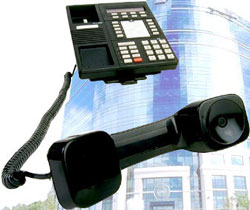People may point and laugh when you tell them your phones are still on analog landlines. Do you have to crank the phone or spin the dial? Very funny… especially when it turns out the joke is on them.
 Those old twisted pair lines were designed to have decent voice quality and rock solid stability. Yes, they can degrade with time. That usually shows up as noise on the line until you can’t make or receive calls. After a quick service call, everything is back in order for another year or two or a decade.
Those old twisted pair lines were designed to have decent voice quality and rock solid stability. Yes, they can degrade with time. That usually shows up as noise on the line until you can’t make or receive calls. After a quick service call, everything is back in order for another year or two or a decade. Oh, but that’s so old fashioned. The new phone line is the Internet. You can ditch the separate wiring and expensive line to the phone company when your computers and telephones share the same broadband connection. You can also get more advanced features, such as phones and computers that work together to support customers.
The only real hitch is that sometimes the new phones don’t measure up to the old phones. Oh, the handsets are great. They’re marvels of electronic engineering. Somewhere, somehow, the performance is getting lost. Calls may start out fine and then get garbled. The distortion can be so bad you can’t understand the caller. Worst case the call gets dropped…. and you slam that fancy handset back in the cradle. Not too hard, though. Those phones are expensive.
Where It All Goes So Wrong
The problem with VoIP or Voice over Internet Protocol telephony isn’t the fundamental digital technology. It’s that Internet thing. The Internet serves everyone, goes everywhere and is cheap as chips, as they say. Anyone and everyone is online doing pretty much everything possible. Your phone call goes into the fray like every other session and winds up at your VoIP service provider. It’s also completely democratic. Your call is no more or less important than somebody streaming a movie or placing an online order.
What you may not realize is that your old phone calls were really dedicated private connections between you and the party you are talking to. The line itself from your building to the phone company is just a pair of wires that go all the way there. A switching system then connects your line to the other party’s line. You have a dedicated circuit for the duration of the call. If the system gets overloaded, the next caller gets a busy signal. On the Internet, nobody gets a busy signal. The system simply slows down or drops bits. That’s what wrecks nice clean phone conversations.
Is There a Way to Make it Better?
The fundamental problem is more bits per second than a connection can handle. First, stop letting your computers and phones fight for the bandwidth. Set your router up to give phone calls priority. Whatever they don’t use can serve the other equipment. If those operations don’t have enough left over, you are going to have to order a higher bandwidth line.
Another thing to know is that the first mile is the worst mile for an Internet connection. The core of the Internet has much higher performance than most local Internet Service Providers. The cheaper the connection, the more likely it is that you’ll be in contention with other users. Dump the shared bandwidth services like cable and cellular broadband in favor of a dedicated Internet connection, like a T1 line. The 1.5 Mbps bandwidth of T1 is probably not going to meet your other needs, so consider this just for the phones. Otherwise get a higher bandwidth service for everything using Carrier Ethernet over copper or fiber.
Get Off The Internet
If you really want to get control of call quality, replicate the old dedicated phone line but with newer technology. What you need is a dedicated line service from your company to your phone service provider. Most PBX systems can use a T1 line, ISDN PRI (another flavor of T1), or a SIP Trunk. SIP Trunking is designed to directly support VoIP telephony.
Note that these dedicated lines go directly from point to point. There is no Internet connection involved.
If you want to tie together several business locations, an MPLS network may be cost advantageous. This is like a private Internet. The difference is that the line quality is carefully maintained by the service provider and is not the free-for-all you get on the Internet. Does it cost more? You bet. It may well be worth it, though, for customer satisfaction and employee productivity.
Are you frustrated with the quality of your phone service or the performance of your entire network? It’s time to take a look at voice and data connections that will get the job done and probably save you more money than they cost.

